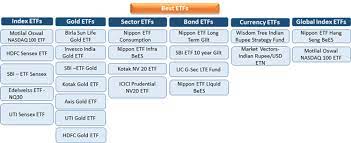Understanding Exchange Traded Funds (ETFs) Benefits, Types, and Associated Risks
Exchange-Traded Funds (ETF) have gained significant popularity in the Indian market as a diversified investment option. ETF provide investors with the benefits of both stocks and mutual funds, combining the flexibility of stock trading with the diversification and professional management associated with mutual funds. This article aims to provide a detailed overview of ETF, highlighting their benefits, various types available in the Indian market, and the associated risks investors should be aware of.
Benefits of ETF:
a. Diversification: ETF offer investors exposure to a broad range of securities, such as stocks, bonds, commodities, or indices. This diversification reduces the risk associated with investing in a single security and helps spread the investment across various asset classes.
b. Lower Costs: ETF generally have lower expense ratios compared to actively managed mutual funds. This cost efficiency is primarily due to their passive investment strategy, which aims to replicate a specific index or sector performance, reducing the need for active management.
c. Liquidity: ETF trade on stock exchanges, providing investors with intra-day liquidity. They can be bought or sold throughout the trading day at prevailing market prices, allowing investors to take advantage of short-term market fluctuations.
d. Transparency: ETF disclose their holdings on a daily basis, enabling investors to make informed decisions. This transparency allows investors to know exactly what assets they own within the ETF and the associated risks.
Types of ETF
a. Equity ETF: These ETF invest in a diversified portfolio of stocks, tracking specific indices like Nifty 50, Sensex, or sector-based indices. Equity ETF provide exposure to the performance of a specific segment of the stock market. Ex: Nifty Bees, Nifty EES, QNifty etc
b. Bond ETF: Bond ETF invest in fixed-income securities like government bonds, corporate bonds, or treasury bills. They offer investors a convenient way to access the fixed-income market with the benefit of diversification and liquidity. Ex. G-Sec ETF, Bharat Bond ETF, etc
c. Gold ETF: Gold ETF invest in physical gold and provide investors with exposure to the price movements of gold without the need for physical storage. They are an efficient way to invest in gold without the associated hassles of buying and storing physical gold. EX. Gold Bees, Gold Share, Can Gold, etc
d. International ETF: These ETF invest in international markets, allowing Indian investors to gain exposure to global equities or specific foreign indices. International ETF provide diversification benefits by accessing markets outside of India. Ex. N100, HNGSENGBEES, etc
e. Sector ETF: Sector ETF focus on specific sectors such as banking, technology, or healthcare, allowing investors to gain exposure to a particular industry or segment of the market. EX. IT BEES, Pharma BEES, etc
 |
| List of ETF |
Risks Associated with ETF:
a. Market Risk: ETF are subject to market volatility and fluctuations in the underlying assets they track. If the market experiences a downturn, the value of the ETF may decline.
b. Tracking Error: ETF aim to replicate the performance of an underlying index, but there can be slight deviations known as tracking errors. These errors can occur due to fees, expenses, or timing differences, impacting the returns of the ETF compared to the index it tracks.
c. Liquidity Risk: While ETF offer intra-day liquidity, some ETF may have lower trading volumes, leading to wider bid-ask spreads. This could result in difficulties while buying or selling ETF shares at favorable prices.
d. Regulatory Risk: Changes in regulations or tax policies can affect the performance and taxation of ETF investments. Investors should stay updated on the regulatory environment and any potential changes that might impact their investments.
ETF have emerged as a popular investment option in the Indian market due to their diversification, cost efficiency, liquidity, and transparency. They offer investors exposure to a wide range of asset classes and sectors, allowing them to tailor their investment portfolios to meet their specific goals and risk profiles. However, investors must be aware of the associated risks, including market volatility, tracking errors, liquidity concerns, and regulatory changes. By understanding these risks and conducting thorough research, investors can effectively utilize ETF as part of their investment strategy in the Indian market.
Disclaimer: The information provided in this article is for educational and informational purposes only and should not be considered as financial or investment advice. The article does not take into account the specific investment objectives, financial situation, or risk tolerance of any individual or entity. Investing in ETF or any other financial product involves risks, and investors should carefully consider their investment goals and seek professional advice before making any investment decisions. While efforts have been made to ensure the accuracy of the information presented, it is subject to change and may not be exhaustive. The article's content is based on the knowledge and information available up to the date of its publication, which is stated at the beginning of the article. There may be new developments or changes in regulations, market conditions, or other factors that could impact the relevance or accuracy of the information provided. Investors should be aware that past performance is not indicative of future results. The value of investments and the income generated can fluctuate, and investors may not get back the full amount invested. All investments involve risks, including the risk of loss of principal. The author and the publisher of this article do not make any warranties or guarantees, express or implied, regarding the accuracy, completeness, reliability, or suitability of the information provided. They shall not be held responsible for any errors, omissions, or any actions taken based on the information contained in this article. Individuals are encouraged to conduct their own research and analysis and seek professional advice before making any investment decisions. They should carefully read the prospectus, offering memorandum, or any other relevant documents associated with ETF or other financial products before investing. In conclusion, readers should exercise caution and judgment when interpreting and applying the information provided in this article and acknowledge that they are solely responsible for their investment decisions.



Comments
Post a Comment